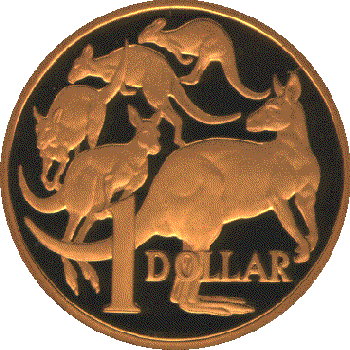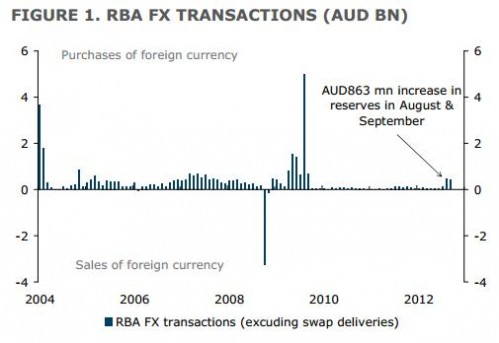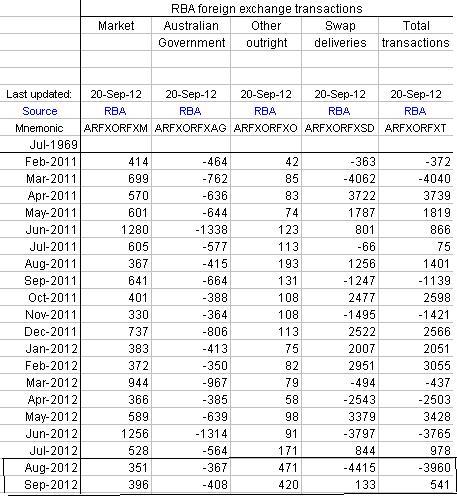
The RBA – leaning against the wind
Is the Reserve Bank of Australia intervening in the market to hold down the remarkably resilient Aussie dollar?
That’s the question commentators and economists are asking themselves following the publication of data at the end of last week (picked up by the WSJ) that showed a significant increase in the pace of foreign exchange accumulation in August and September.
From the RBA’s Foreign Exchange Transactions and Holdings of Official Reserve Assets:
Now, it’s the bottom two rows that’s of interest here. Andrew Salter, ANZ’s FX strategist calculates the RBA has piled up A$863m of foreign exchange reserves in August and September. To put those figures in perspective the post January 2010 pace of reserve accumulation is just A$54m.
Here’s what he thinks has been happening:
In the course of its operations, the RBA accumulates foreign currency on its balance sheet that is unrelated to the management of its reserve assets. Usually this foreign currency is exchanged back into Australian dollars in the market. Data released in its monthly statistical tables suggests that for the past two months the Bank has continued to accrue this foreign currency, but that it has elected to not convert it back into Australian dollars in the market. The RBA is thereby reducing upward pressure on the Australian dollar exchange rate through this action (see Figure 1).

In Salter’s eyes the decision to accrue foreign currency sends a clear signal of an “evolution” in the RBA’s view on the currency and its indication to act.
Indeed, members of Reserve Bank Board have cranked up the rhetoric on the dollar over the past month, and the RBA acknowledged in September that the current was “weighing more heavily on the economy than might be expected“. But no matter. This still looks to be significant, even if the actions of the RBA can be more accurately described as “leaning” rather than intervening” in the currency.
Back to Salter:
To be sure, the RBA is not actively attempting to influence the level of the exchange rate. But by electing to reduce additional demand for the currency in the market, it is ‘leaning’ against the Australian dollar’s appreciation. A lower equilibrium level is therefore a natural by-product compared to what would have otherwise been the case.
Rather, the strategy is attempting to achieve three specific objectives:
– Accommodate a small portion of foreign portfolio demand for Australian dollar denominated assets.
– Send a signal to investors positioning for an appreciation in the currency on the basis of foreign demand that it is prepared to absorb part of it, and therefore that such positioning may not be as profitable as may be perceived
– Prepare for the eventual unwind of foreign demand by building up its coffers of foreign exchange.
So what happens next?
Salter reckons the RBA takes a step back and sees how its little experiment in ‘smoothing and testing are received by the market.
The price action on Monday morning suggests investors have registered the move…
… and aren’t overly surprised, which Salter attributes to the fact that the RBA has already been signalling its views on the exchange rate for some time. Plus, the relative size of the (in)action is small:
The size of the transactions – in total around AUD800 million – are also very modest. This represents around AUD20 million per trading day, compared to the typical average daily spot market turnover of around AUD4 billion per day (between banks and nonfinancial institutions).
The RBA is not seen as being likely to go Swiss on its currency any time soon:
More intervention would likely be needed to bring down the exchange rate in any material way. And since the RBA is cognisant of its ability to engineer the exchange rate under the limits of its balance sheet, and the yield opportunity cost and credit risk of investing in US dollars or euros, as compared to Australian dollars, it is unlikely to seek to accumulate foreign exchange reserves in any material way (without a significant further development in the over-valuation of the currency or portfolio flows). As such we remain constructive on the outlook for the Australian dollar, but perhaps a little more cautiously than a few months earlier.
But if it wanted to, this ” how to clip the Aussie dollar” guide by Warwick McKibbin, professor of economics at ANU and a former RBA board member, is worth a read.
And then from Antipodean intervention
Good points here from Citi’s Todd Elmer. First he mentions the flip side of the RBA’s inaction — foreign central bank buying of the Aussie. He argues that the more important factor for Aussie direction is likely to remain the degree of foreign appetite. But it’s the signalling issue we think is most worth noting (our emphasis):
Indeed, the stronger signal from the reserves data may be that demand for AUD remained healthy in August and September. Again considering official sector flows, the COFER data shows about $21bn in buying of smaller currencies in Q2 2012. This follows the surprising selling of small currencies in Q1, so it looks like appetite was again building following the blow to confidence and flight-to-safety associated with the intensification of the European sovereign debt crisis. The past relationship between foreign official buying of AUD and RBA foreign currency reserves accumulation, shows that spikes in the former often coincide with rises in the latter (although this pattern was notably absent in 2011 – see Figure below). As such, larger RBA foreign reserves accumulation could provide a ‘leading’ indication that reserves manager appetite for AUD was still rebounding through Q3. Since Q3 covers a period of significant uncertainty on the European sovereign debt crisis and the trajectory of Asian growth, the forward looking implication is that demand for AUD among external investors may grow even stronger now that conditions have improved somewhat.
Of course, it is possible that the apparent shift in reserves management is part of a suite of measures intended to signal increased discomfort with the exchange rate. The implicit ‘threat’ is that further action could be taken if imbalances grow. However, we believe that this signaling effect on AUD will be weak. That is because it would be difficult for the RBA to directly control the trend in the exchange rate even if it fully set itself to the task. The RBA has direct control over interest rates, but recent easing has done relatively little to derail AUD. Stronger verbal intervention on the exchange rate could be seen, but it is unlikely that this would be viewed as the prelude to heavy-handed Swiss-style intervention since a move to target the level and the direction of the exchange rate would not be seen as credible.
The problem for Australia is that, unlike Switzerland, it does not face deflation and exceptionally weak growth, so it is likely that any intervention policy will be viewed as unsustainable. This might only encourage investors to buy more AUD in anticipation of an eventual reversal of the currency policy. As always, the exact degree of demand for AUD is likely to be a function of risk appetite among investors. Risk appetite is more heavily influenced by developments in China, the US and Europe than it is RBA policy. Should risk appetite continue to rise, the best the RBA could hope for would be to influence the level at which AUD buying occurs.


